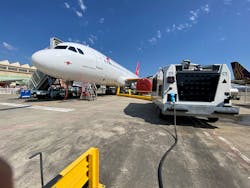The Benefit of Uniting Ground Power and Conditioned Air
When ground support equipment (GSE) with electric motors or diesel engines can be utilized to power and cool aircraft on the ground, it allows the plane’s auxiliary power unit (APU) to be turned off. With less jet fuel being consumed at the gate, environmental factors and airlines’ operating costs improve.
To assist with this, Guinault has developed a combination air conditioning unit (ACU) and ground power unit (GPU). The G15 ACU/GPU combines the advantages of an air conditioner and generator and benefits from the technical developments Guinault has achieved over a timespan of more than 60 years.
According to Lionel Clermont, Guinault’s president and CEO, GPUs for decades have been a primary energy source for aircraft on the ground and air start units (ASUs) have been necessary only in the case of an APU failure. ACUs have been viewed as an option, in hot weather.
Today, Clermont says that’s changing.
“ACU is becoming mandatory, together with the GPU, and in certain cases ASU, as we are looking for a substitution to the APU,” he says.
“Having the GPU and ACU combined in a single unit appears to make sense, as both functions are simultaneously required in most of the cases,” Clermont says, noting the combination offers operation savings for fuel, handling and maintenance. “The expertise of Guinault in electronics, alternators and thermodynamics was the necessary tool to make it right.”
The ACU/GPU combo provides aircraft power (400 Hz or 28VDC) and aircraft air conditioning -- either separately or simultaneously.
The ACU maintains the correct temperature in the cockpit and cabin during pre-flight operations, boarding and maintenance. The unit adapts its flow and cooling power to a variety of aircraft types, weather conditions and airline requirements in terms of cabin temperature and ventilation. It also helps meet the needs and requirements of code B and C civil aircraft in continental, tropical or desert climates. Lastly, the ACU dehumidifies the air to avoid frost in the heat exchanger.
While the idea of having a combo unit is not new, Clermont says this unit is notable because of the dual voltage alternator.
“The concept does not require any sensitive and complex frequency converter, is easier to maintain and is more reliable,” says Clermont, noting the Guinault combo unit entered the market in 2016 and was improved in 2019 with a more efficient cooling concept.
One of the benefits of combining two units into one was one-person operation for two functions, resulting in reduced handling, fuel, power consumption and maintenance.
And that’s the main advantage, he says. A diesel-driven combo unit ensures up to a 90 percent carbon emissions reduction over an APU. An electrically driven solution will ensure an additional offset of 5 to 10 percent, depending on the carbon content of the electrical power.
The combo unit is reliable because it uses a two-stage cooling circuit with the dual voltage alternator. No frequency converter is required.
One single, user-friendly human machine interface (HMI) with smart features allows fast cooling, the ability to stop the machine in a short time and no-frost operation through a dual stage cooling system. Detailed technical remote monitoring and a log of events ensures good technical support from the manufacturer. What’s more, low pressure fluid ensures compatibility with the clean refrigeration gas that has already become mandatory in other industries.
The GF15 Combo unit is most ideal for narrow-body aircraft and can be used for aircraft up to the Boeing 737 and Airbus 320 (Code C).
If the ACU is rarely needed, Clermont says the combined unit might not be the right fit.
Options for the GF15 Combo unit include a heating mode, 400 Hz / 200 VAC power supply, 28VDC power supply, and cold temperature kit for start-up in temperatures below -25 degrees C.
Guinault has been supplying electric current to aircraft since 1949. The generators of that time mainly supplied continuous electric current at 28 volts. In the early 1970s, as the first 400 Hz aircraft landed in Europe, Guinault was asked by its airline customers to manufacture a 400 Hz GPU. Later in the early 1990s Guinault began manufacturing multi-voltage GPUs based on multi-coil alternators. That allowed for a very compact unit, which was highly appreciated for military use.
Today, Guinault still designs and manufactures its alternator in-house.
“The alternator expertise has become a key success factor in the GPU, and later in the combined ACU/GPU. The combo unit would not have existed in its robust and reliable form without a dual voltage, unique Guinault alternator,” says Clermont.
Based on the company’s ability to innovate and understand military requirements, Guinault in 1993 designed a compact air conditioning unit for aircraft manufacturer Dassault.
In 2000, an electric ASU joined Guinault’s GPU and ACU equipment lineup. With its 1,300-2,000 rpm variable engine rpm operation, the electric air start unit concept offers fuel savings compared to a conventional ASU fitted with a pneumatic air controller, Clermont says.
“As we found that we could bring 30 percent savings through our innovation in the electronic control of the compressor, we decided to come with a new ASU,” he says.
Guinault came out with an ACU/GPU and ACU range of products as the company understood it could bring relevant savings and enhanced performance to the ACU, within a combined unit based on the dual voltage alternator.
“ACU is a natural step beyond the ASU, as both units are based on compressors and use the thermodynamics rules. Guinault stays on the APU-off path, and aims to come with different products, based on deep in-house technological expertise: alternator, power electronics, thermodynamics and refrigeration,” Clermont says.
About the Author
Rebecca Kanable
Assistant Editor
Rebecca Kanable, a veteran journalist, worked with Endeavor Business Media's aviation group from 2021 to 2024 as assistant editor of Airport Business, AMT and Ground Support Worldwide. She previously worked for various publications, including trade magazines and newspapers.

